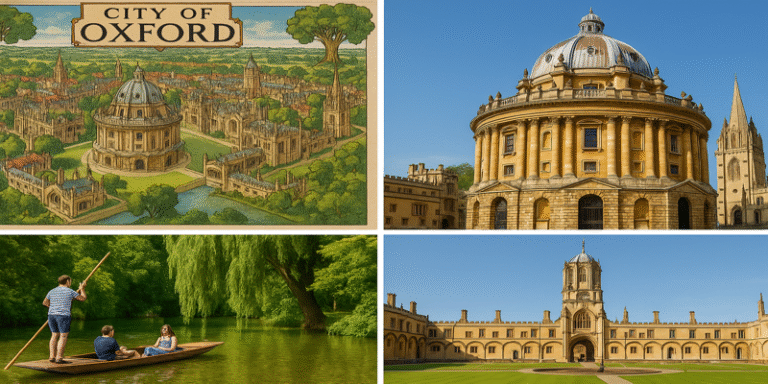Oxford, located in the county of Oxfordshire, is one of the most historically and culturally significant cities in the United Kingdom. Known worldwide for its prestigious university, its history stretches back over a thousand years, combining medieval charm with a vibrant, modern cultural life. For centuries, Oxford has been a hub for intellectual exchange, literary inspiration, and architectural marvels, attracting visitors from across the globe.
Historical Context
Oxford’s origins can be traced to the Saxon era, with documentary evidence of its existence in the 9th century (Crossley, 1979). The city developed as a strategic crossing point over the River Thames, and its name derives from “Oxenaforda”, meaning a ford for oxen (Salter, 1920). By the 12th century, Oxford had emerged as a centre for learning, leading to the establishment of the University of Oxford, which remains one of the most prestigious institutions of higher education in the world (Catto, 1984).
The medieval period witnessed the growth of both the university and the town, although relations between the two were not always harmonious. Notably, the 1355 St Scholastica Day riot resulted in significant loss of life, reflecting tensions between students and townsfolk (Darwall-Smith, 2008). Despite such disputes, Oxford flourished academically and culturally, influencing intellectual life throughout Europe.
The University of Oxford
The University of Oxford is at the heart of the city’s identity. Comprising 39 independent colleges, each with its own governance, traditions, and architecture, the university operates as a collegiate system. The university’s reputation has been built on centuries of scholarship, producing leaders, scientists, writers, and public figures who have shaped global discourse (Brock & Curthoys, 1997).
Walking through the city, visitors encounter iconic academic landmarks such as the Bodleian Library, one of the oldest libraries in Europe, and the Radcliffe Camera, a striking circular reading room completed in 1749 (Tyack, 1998). Christ Church, one of the largest colleges, has been both a place of worship and a political seat of power, while also inspiring fictional worlds in literature and film.
Architectural Heritage
Oxford’s architectural landscape is an open-air museum, encompassing styles from the medieval period through to the modern era. The city is particularly renowned for its Gothic and Gothic Revival architecture, with notable examples including the University Church of St Mary the Virgin and Magdalen College’s iconic tower (Sherwood & Pevsner, 1974).
Baroque influences can be seen in buildings such as Queen’s College, while the neoclassical Sheldonian Theatre, designed by Christopher Wren, reflects the city’s architectural diversity (Tyack, 1998). The historic Covered Market, dating from the 18th century, continues to serve as a focal point for local commerce and artisan trade.
Cultural Life
While Oxford is steeped in tradition, it is also a vibrant cultural centre. The Ashmolean Museum, founded in 1683, is the oldest public museum in Britain and houses world-class collections of art and archaeology (MacGregor, 2015). The Museum of Natural History, famous for its neo-Gothic architecture, and the Pitt Rivers Museum, with its anthropological treasures, offer insights into human history and the natural world.
The city’s literary connections are particularly rich. Oxford has inspired authors such as J.R.R. Tolkien, C.S. Lewis, and Philip Pullman. The Eagle and Child pub, frequented by the literary group known as the Inklings, remains a popular destination for literary enthusiasts (Carpenter, 1978).
The performing arts also thrive in Oxford. The Oxford Playhouse, New Theatre, and Sheldonian Theatre host a wide range of productions, from student performances to internationally acclaimed touring shows. The annual Oxford Literary Festival attracts renowned authors, fostering a continued tradition of intellectual exchange.
Green Spaces and the River Thames
Oxford is also notable for its green spaces and waterways. The University Parks offer a tranquil retreat from the city’s bustle, while Christ Church Meadow provides picturesque walks alongside grazing cattle and views of the college’s grand architecture.
The River Thames, known locally as the Isis, is central to Oxford’s recreational life. Punting — propelling a flat-bottomed boat with a long pole — is a quintessential Oxford experience, popular among both residents and visitors (Howkins, 2003). Rowing is another tradition, with events such as the annual Boat Race against Cambridge attracting national attention.
Tourism and Accessibility
Oxford’s popularity as a tourist destination is bolstered by its proximity to London, just an hour away by train. The city welcomes millions of visitors annually, drawn by its blend of academic heritage, historical architecture, and vibrant culture (Visit Oxfordshire, 2023).
Walking tours, both guided and self-directed, allow visitors to immerse themselves in the city’s history. Specialist tours focus on themes such as literary heritage, architecture, and university life. Cycling is another popular way to explore, with dedicated bike lanes and scenic routes.
The city also serves as a gateway to the surrounding Cotswolds, a designated Area of Outstanding Natural Beauty, providing opportunities for countryside exploration.
Sample Exploring Itinerary
| Activity | Description |
| Breakfast at The Vaults & Garden Café | Located by the University Church of St Mary the Virgin, this café offers a hearty start with locally sourced food and views of the Radcliffe Camera. |
| Bodleian Library & Radcliffe Camera | Join a guided tour of the Bodleian Library, exploring centuries-old reading rooms and admiring the Radcliffe Camera’s neoclassical beauty. |
| Sheldonian Theatre | Designed by Sir Christopher Wren, the Sheldonian offers panoramic views of the city from its cupola. |
| Covered Market | Browse artisan stalls, sample fresh produce, and enjoy the bustling atmosphere of this 18th century indoor market. |
| Lunch at The Eagle and Child | Soak in literary history at this famous pub once frequented by Tolkien and C.S. Lewis. |
| Ashmolean Museum | Spend an hour exploring treasures from ancient civilisations to modern art. |
| Christ Church College & Meadow | Tour one of Oxford’s grandest colleges, with its cathedral, dining hall, and landscaped meadows. |
| Punting on the River Thames (Isis) | Hire a punt for a tranquil glide along the river, enjoying Oxford from a unique vantage point. |
| Dinner at Gee’s Restaurant | Relax in a Victorian glasshouse restaurant, savouring Mediterranean-inspired dishes before heading home. |
Visiting Oxford is to step into a living tapestry of history, academia, and culture. From the spires of its medieval colleges to the bustling energy of its markets and festivals, the city offers something for every interest. Whether strolling through the cloisters of centuries-old colleges, exploring world-class museums, or enjoying the tranquillity of the river, Oxford remains a place where the past and present meet in harmonious dialogue.
Its unique character lies in its ability to maintain tradition while embracing change, making it an enduring source of inspiration for scholars, artists, and travellers alike.
References
Brock, M. & Curthoys, M.C. (1997) The History of the University of Oxford: Volume VI: Nineteenth-Century Oxford, Part 1. Oxford: Oxford University Press.
Carpenter, H. (1978) The Inklings: C.S. Lewis, J.R.R. Tolkien, Charles Williams, and Their Friends. London: Allen & Unwin.
Catto, J.I. (1984) The History of the University of Oxford: Volume I: The Early Oxford Schools. Oxford: Oxford University Press.
Crossley, A. (1979) A History of the County of Oxford: Volume IV. London: Victoria County History.
Darwall-Smith, R.H. (2008) A History of University College, Oxford. Oxford: Oxford University Press.
Howkins, A. (2003) The English Countryside Between the Wars. Manchester: Manchester University Press.
MacGregor, A. (2015) Curiosity and Enlightenment: Collectors and Collections from the Sixteenth to the Nineteenth Century. New Haven: Yale University Press.
Salter, H.E. (1920) The Oxford City Properties. Oxford: Clarendon Press.
Sherwood, J. & Pevsner, N. (1974) The Buildings of England: Oxfordshire. Harmondsworth: Penguin Books.
Tyack, G. (1998) Oxford: An Architectural Guide. Oxford: Oxford University Press.
Visit Oxfordshire (2023) Welcome to Oxfordshire. Available at: https://www.experienceoxfordshire.org (Accessed: 5 August 2025).









